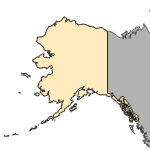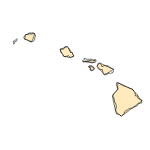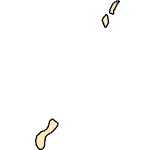Batrachoseps attenuatus
(California Slender Salamander)
Amphibians-Salamanders
Native Transplant |
|
Common name: California Slender Salamander
Taxonomy: available through
www.itis.gov
Identification: Very slender, with tail approximately twice as long as body (snout-vent length, SVL); short limbs, with hind feet each having four digits; red, brown, or yellow dorsal stripe that varies with geographic locale (Stebbins and McGinn 2012).
Size: 32-47 mm SVL, ~150 mm
Native Range: Extreme southwestern Oregon south to the South Coast Range, CA, as well as scattered populations in Sierran foothills and Great Valley, CA (Stebbins and McGinnis 2012).



|

Alaska |

Hawaii |

Puerto Rico &
Virgin Islands |

Guam Saipan |
Hydrologic Unit Codes (HUCs) Explained
Interactive maps: Point Distribution Maps
Nonindigenous Occurrences:
One pregnant female was captured in Kirkland, WA (Freni et al. 2022).
Table 1. States with nonindigenous occurrences, the earliest and latest observations in each state, and the tally and names of HUCs with observations†. Names and dates are hyperlinked to their relevant specimen records. The list of references for all nonindigenous occurrences of Batrachoseps attenuatus are found here.
Table last updated 12/19/2025
† Populations may not be currently present.
Ecology: Relatively common in urban and suburban areas such as gardens and parks, including disturbed areas and those with other invasive species such as ice plant (Mesembryanthemum sp.), but natural habitat includes oak savannah, chaparral, woodland, and forests where (Stebbins and McGinnis, 2012). California Slender Salamanders are typically found under leaf litter, logs, rocks, and other debris, and may use earthworm burrows; eggs are laid underground or under debris, and communal "nesting" by several individuals is thought to occur (Stebbins and McGinnis 2012). Diet consists of small invertebrates, such as small slugs and snails, spiders, mites, millipedes, isopods, insects, and newly-hatched earthworms within earthworm burrows (Stebbins and McGinnis 2012).
Means of Introduction: Most likely interstate transport of plants or timber, but possibly a released or escaped pet (Freni et al. 2022).
Status: Unknown, but individual captured in Kirkland, WA was a pregnant female (Freni et al. 2022).
Impact of Introduction: The impacts of this species are currently unknown, as no studies have been done to determine how it has affected ecosystems in the invaded range. The absence of data does not equate to lack of effects. It does, however, mean that research is required to evaluate effects before conclusions can be made.
References: (click for full references)
Freni, O., J. Freni, C.D. Anderson, L. Hallock, M.R. Lambert, N. Van Gilder, D.B. Wake, E.L. Jockusch. 2022. First record of a Slender Salamander (Genus Batrachoseps) introduced to Washington State and molecular source identification from San Francisco, California. Northwestern Naturalist 103(1):81-87.
Stebbins, R.C. and McGinnis, S.M. 2012. Amphibians and reptiles of California. Revised edition. California Natural History Guides, Berkeley, CA.
Author:
Freedman, J.A.
Revision Date: 3/14/2022
Citation Information:
Freedman, J.A., 2025, Batrachoseps attenuatus (Eschscholtz, 1833): U.S. Geological Survey, Nonindigenous Aquatic Species Database, Gainesville, FL, https://nas.er.usgs.gov/queries/FactSheet.aspx?SpeciesID=3799, Revision Date: 3/14/2022, Access Date: 12/20/2025
This information is preliminary or provisional and is subject to revision. It is being provided to meet the need for timely best science. The information has not received final approval by the U.S. Geological Survey (USGS) and is provided on the condition that neither the USGS nor the U.S. Government shall be held liable for any damages resulting from the authorized or unauthorized use of the information.